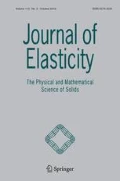Abstract
Invaginations are partial enclosures formed by surfaces. Typically formed by biological membranes; they abound in nature. In this paper, we consider fundamentally different structures: elastically stabilized invaginations. Focusing on spherical invaginations formed by elastic membranes, we carried out experiments and mathematical modeling to understand the stress and strain fields underlying stable structures. Friction plays a key role in stabilization, and consequently the required force balance is an inequality. Using a novel scheme, we were able to find stable solutions of the balance equations for different models of elasticity, with reasonable agreement with experiments.





Similar content being viewed by others
Notes
The modulus and thickness of the membranes were measured by us.
References
Stillwell, W.: An Introduction to Biological Membranes: Composition, Structure and Function. Elsevier Scientific, New York (2016)
Meng, F., Doi, M., Ouyang, Z., et al.: The ‘coin-through-the-rubber’ trick: an elastically stabilized invagination. J. Elast. 123, 43–57 (2016)
Euler, L.: Methodus inveniendi lineas curvas maximi minimive proprietate gaudentes, sive solutio problematis isoperimetrici latissimo sensu accepti. In: Additamentum I (De curvis elasticis), pp. 245–320 (1744)
Varenberg, M., Varenberg, A.: Table tennis membrane: tribological characterization. Tribol. Lett. 47, 52–56 (2012)
Liu, Y.F., et al.: Experimental comparison of five friction models on the same test-bed of the micro stick-slip motion system. Mech. Sci. 6, 15–28 (2015)
Mooney, M.: A theory of large elastic deformation. J. Appl. Phys. 11(9), 582–592 (1940)
Rivlin, R.S.: Large elastic deformations of isotropic materials. IV. Further developments of the general theory. Philos. Trans. R. Soc. Lond. Ser. A, Math. Phys. Sci. 241(835), 379–397 (1948)
Audoly, B., Pomeau, Y.: Elasticity and Geometry: From Hair Curls to the Non-linear Response of Shells. Oxford University Press, Oxford (2010)
Gent, A.N.: A new constitutive relation for membrane. Rubber Chem. Technol. 69, 59–61 (1996)
Acknowledgements
This work was supported by the Office of Naval Research through the MURI on Photomechanical Material Systems (ONR N00014-18-1-2624).
Author information
Authors and Affiliations
Contributions
All authors contributed equally to this work.
Corresponding author
Ethics declarations
Conflict of interest
We have no conflict of interest.
Competing interests
The authors declare no competing interests.
Additional information
Publisher’s Note
Springer Nature remains neutral with regard to jurisdictional claims in published maps and institutional affiliations.
Rights and permissions
Springer Nature or its licensor holds exclusive rights to this article under a publishing agreement with the author(s) or other rightsholder(s); author self-archiving of the accepted manuscript version of this article is solely governed by the terms of such publishing agreement and applicable law.
About this article
Cite this article
Zheng, X., Guo, T. & Palffy-Muhoray, P. An Elastically Stabilized Spherical Invagination. J Elast 153, 723–733 (2023). https://doi.org/10.1007/s10659-022-09927-y
Received:
Accepted:
Published:
Issue Date:
DOI: https://doi.org/10.1007/s10659-022-09927-y



